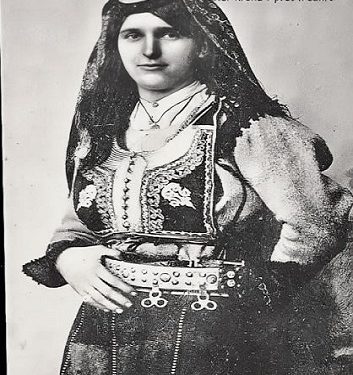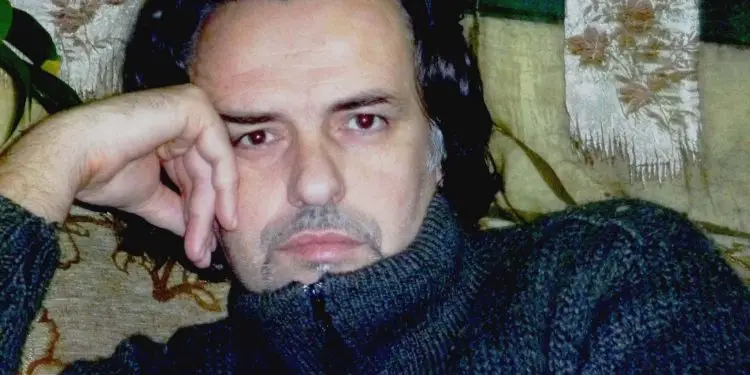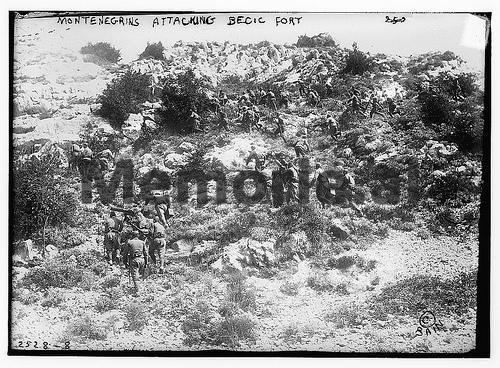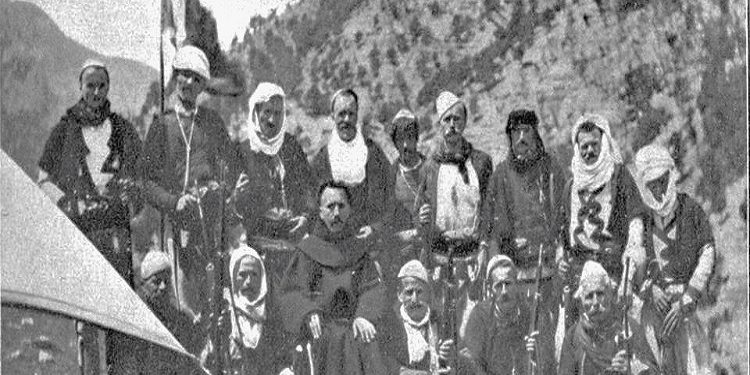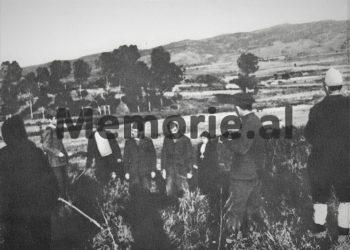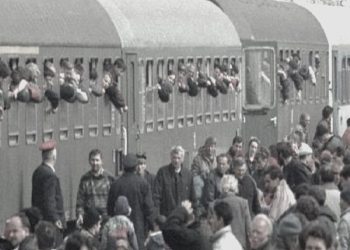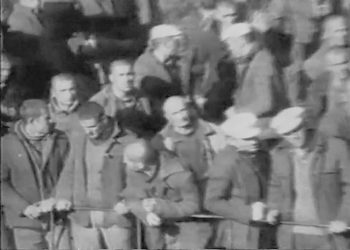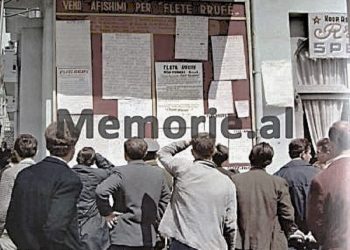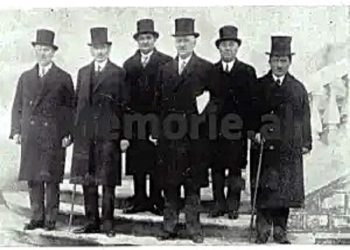“A rare photograph and the truth of the Highlander woman who turned into a legend”
Memorie.al / The photograph of this highlander woman from the beginning of the last century was printed on the postcards of the time with the inscription: “Souvenir from Shqypënia” (Albania), “Nuk a grue, por ashtë Krajlic/ Katër Krêna, i pret n’sakic” (She is not a woman, but she is a Queen/ Four Heads, she cuts them with an axe). In contrast to another, perhaps later, print bearing the French inscription “Souvenir de Scutari d’Albanie” (Souvenir from Shkodra of Albania), it is more complete as an image, perhaps for reasons of centering the subject, which would have a graphic harmonization in case of stamping and reproduction for commercial purposes. Both of these prints date the photo to January 25, 1910, and accompany it with the caption: “Albanian woman from Shkodra, with an embroidered vest, a considerable belt (with rings for hanging things) and a floral scarf”!
In an attempt to find out more, perhaps even to link the photo, which may simply have been printed or taken in Shkodra, but had a peripheral connection to this Northern center, and also referring to the two-line verse, which was most likely a reproduction of a song fragment: “Kajë Selmanja, o ku je/ N’krye Nokshiqit, me shkij tuj pre” (Kajë Selmanja, where are you/ At the head of Nokshiq, cutting down Slavs), dedicated to this woman, enriched with other verses by the rhapsodes: “Nuk a grue, por ashtë Krajlic/ Katër Krêna, i pret n’sakic” (She is not a woman, but she is a Queen/ Four Heads, she cuts them with an axe). I managed to find and attach the story to the photo. Because, as in the case of Nora of Kelmendi, Tringë Smajlaj, or Mrika who avenged her husband’s blood, in this case too, the personalized photo would inevitably be connected to a story, to a character, to the truth that comes from deep in time, through songs, but also through historical treatises.
Moreover, according to Prof. Adem Geca, whom we refer to for shedding light on this emblematic female figure, Kajë Galë – Selmanja, and her son, Ymer Maliqi, were decorated by President Sali Berisha in 1993, for their act of heroic armed resistance in the war against the Montenegrins.
And here we are, at the armed uprising that took place in Gjakova and the role played not only by men but also by women like Kajë Galë – Selmanja. As was known, with the diplomatic action of the spring of 1879, the League of Prizren removed the right of the Sublime Porte to speak on behalf of Albania, because from now on, it would be the Albanians who would speak and act on behalf of their fate.
“Furthermore, her heroic resistance caused the decisions of the Congress of Berlin, which violated the national interests of Albania in favor of Montenegro, Greece, and Serbia, to be delayed and not immediately implemented…!” The Great Powers had agreed among themselves, against the vital interests of Albania and the Albanians, using their territories as currency for bartering in favor of the monarchist states of the Balkans,” explains Prof. Adem Geca, in the article published on 30.09.2010, Banjë.
In a telegram from the Albanian inhabitants of the Plava and Gucia regions, sent to the chancelleries of the Great Powers, regarding the handover of these entirely Albanian regions to Montenegro, it is stated: “We have learned that you have been sent by your governments for the demarcation of Montenegro’s borders. The demarcation of the borders cannot be done without the consent of all of Albania.” The right of the Albanians did not find justice. The word remained powerless in the face of the fragmentation of Albanian lands.
The anti-Albanian decisions for the implementation of territorial obligations towards Montenegro meant war until death for the patriotic freedom-loving forces working and operating within the framework of the Albanian League. All kinds of promises were offered to the inhabitants of Plava and Gucia to accept the annexation, but the people and the elders were resolute: No and no, we will not give up a single inch of land. The folk singer immortalized this vital moment for this population as follows: “We have been left an ancestral trust/ Do not abandon this homeland”!
Marko Milani, with 5,600 forces, set off towards the Albanian border. Faced with this extremely difficult situation, the war committee of the League of Prizren raised the alarm. Young and old, men and women became the resistance for the defense of Albania from fragmentation. Blood flowed like a river!
According to the testimonies of the Montenegrin fighters themselves, the Albanian resistance was terrifying; according to their legends, every bush, stone, fence, and trunk produced one or many soldiers. The war was truly terrible, hand-to-hand. On the first day of the battle, among the men who distinguished themselves, there was also a woman, a daughter of the martyred Rugova, of the Bajraktar (Flag-bearer) family of Koshutani, married in Nokshiq, to the Buçaj tribe. Everyone knew her by the name: Kajë Galë-Selmanja.
She was the daughter of Shaban Smajli, the child of two brothers with Zhujë Selmani of Koshutani. The folk singer, who is believed to have been somewhere in the front lines of the battle fire, says: “Zhuj’s sister, a defiant ridge, cuts four men with an axe.” This approximate definition is found in the inscription of the photo accompanying the highlander woman, who is Kajë Galë – Selmanja, “Nuk a grue, por ashtë Krajlic/ Katër Krêna, i pret n’sakic.”
The unparalleled heroism of Kaja and the Albanian bravery led Sulejman Agë Vokshi, the Military Head of the Albanian League, to bring her to Nokshiq. As a sign of honor, S. Vokshi brought the lioness of the Battle of Nokshiq before the Albanian soldiers and, for her military merits, gave her a rifle with one hundred bullets. According to Shefqet Cahani, he had told her: “Keep this rifle, from now on, every time we are attacked, respond with this.”
When asked about the unprecedented heroic act in this century of Kajë Galë Selmanja, her nephew Syla recounted to the author: “Mother Kaja did not speak about this event with pleasure, but others spoke more about her unparalleled bravery. It was the first day of the Battle of Nokshiq. The men of the Buçaj tribe had long since joined the freedom fighters, while family members, women, and children were sheltered in a place somewhat far from the course of the war.
Kaja had not wanted to leave the house and the livestock, which were not few. Suddenly, Montenegrin forces were penetrating the village. The path to join the family members of the house and those of the village was closed. While she was heading towards the tower, Sadri Groshi, an 85-year-old man, suddenly entered the courtyard of the house. ‘I needed you too,’ Kaja had whispered then, believing that he could only bring trouble,” further clarifies Prof. Adem Geca in his elaboration.
She takes him by the arm and leads him into the tower. She puts the drang (bolt/bar) on the tower door. She climbs to the second floor. She takes out a rifle and begins the resistance from the arrow slits (frëngjitë) of the tower. She had only a few bullets, but her position was ideal: one bullet, one Montenegrin. While Kajë Galja fired sometimes from one, and sometimes from another embrasure, Sadri Groshi was tasked with shouting as loud as he could: ‘Wait for Maliqi’s boys, wait for them’!
When the bullets ran out and the tower door was broken, the Montenegrins rushed toward the second floor of the tower. Then Kaja was determined to continue the resistance until the end. She pulls Sadri behind the door, grabs an axe and…! The first soldier enters, Kaja, bam with the axe, and the Montenegrin is headless. The second one enters, Kaja bam, the third, the fourth, they met the same fate.
After the retreat of the Montenegrin soldiers, Sadriu recounted, we left the room bathed in blood. Then I saw that Kaja was also wounded, but she didn’t show it. During the attempt to tie her wound a little, her husband Gali showed up, terrified. ‘Where were you, may the blood soak you, how has it soaked you!’ While Kaja, as if nothing had happened, answered: ‘Just as you see!'”
Then Sadriu takes her by the hand and leads her upstairs to the tower. What he saw: Montenegrins sprawled everywhere with severed heads, immersed in their own blood. Kaja’s heroic act became a motif. This is how the people of Nokshiq spoke, and still speak, about the heroic act of this daughter of Rugova. And as was the tradition of the Albanians, Kaja deserved the honor of standing alongside those brave men, who had proven themselves by bleeding in battles with enemies.
The family resistance of this household, like a good mountain clock, was also conveyed by the folk genius through verses. In resistance now are the mother with her daughters, Bega and Lace, and her sons, Zymeri and Ymeri, surrounded for life or death. The heroism of Kajë Galë, as a pivotal figure in this work, becomes even more convincing when we see her resistance as a collective – the entire family. The siege described in the song belongs to 1918, during which her son, Zymeri, is killed.
Gali, Kaja’s husband, is killed in the Battle of Nokshiq, and according to tradition, Kaja is forced to remarry into this family, with Maliqi, who is also killed early, in a confrontation with the Montenegrins. Maliqi, Kaja’s second husband, had four sons from his first marriage: Jahe, Syle, Deli, and Ali, all killed in ambushes and continuous confrontations with the Montenegrins, during the period 1913-1946. None of Maliqi’s four sons managed to pass the age of 23, except Deli, who, after being killed, left only one daughter, Xhemile; the others were unmarried.
This best illustrates the fate of countless generations, upon whom the tragedy of a murderous drama was played out, for a people who asked for nothing but to remain free on their land. And this family, this legendary mother, would continue to give birth to and raise brave men who gave their lives for freedom. They watered the land of their ancestors with blood.
Others about Kajë Galë-Selmani. Sylë Buçi speaks proudly of the resolute character of his grandmother, recounting the case when she was in battle with her son, Imer, when Imer was wounded, his comrades called out to her, sword to sword: “Oh Kajë Galja, Oh ho, your son is wounded, more,” she, with the greatest composure, answered him, sword to sword: “May the wounds be for good, I am going further for Shekuallar (likely an archaic/local term for a place/objective), with my comrades.”
Kajë Galë-Selmanja lived for 100 years. Physically, she was nearly 2 meters tall, a beautiful girl, a beautiful bride, and this beauty accompanied her even in old age. Her character was strict, just; she demanded that others honor her because she honored them. She demanded special respect from the women of the house; none of the women dared to sit before she did. She respected religion and performed her duties to the extent of her ability. She never removed the weapons from her waist.
Tobacco and coffee were her passions; of jewelry, she loved rings, always wearing them on her fingers. But above all, her dearest and most sacred possession was the silver medallion, which was given to her by Sylejman Agë Vokshi for her bravery and patriotic activity. This medallion reminded her of the stormy days of bravery, many memories from the battles, and she wore this medallion with rightful pride…!
“The history of this medallion is strange,” explains the researcher. How it traveled to Istanbul remains to be investigated. Prof. Cahani declares that he discovered it in a suburb of Istanbul, inhabited by Bosnian-Albanian and Albanian-Rugova populations from the Sandžak. As Cahani says, the woman from whom I bought the medallion wished to remain anonymous.
As her nephew, Sherif Buçaj, puts it, along with Kaja’s missing medallion, it seems that they disappeared on the day her son, Ymer, was found dead in Koshutan, August 1946. Along with the medallion, the silver watch chain with the watch, the pipe, the personal revolver, and the rifle, which she never took off, disappeared! Her remains rest among the graves of the people of Nokshiq. Nothing else Albanian remains, but them. Last year, her nephew Syla, along with Sherif, erected her tombstone.
Prof. Adem Geca strives to convey in detail the entire history of this woman and her family, as an effort to fix in memory the armed resistance and resilience of the men and women of this land, in defense of the homeland and freedom.
Drawn by the photograph and the two-line verse of the song: “Nuk a grue, por ashtë Krajlic/ Katër Krêna, i pret n’sakic,” stamped on it, and by the inadequacy of information about this woman, who joins the ranks of the highlander women – those who were daughters, wives, and mothers, but who remain heroines in the history of the Albanians, whose deed and heroic act are an example of inspiration, honor, and gratitude – I tried to do something.
Supported by the treatise of Prof. Adem Geca and the publication of Adem Kelmendi, I believe that this elaboration modestly contributes to filling the gap of authenticity and clarification, not only of the history of a photo but also of the perpetuity of the name and work of Kajë Galë -Selmanja./Memorie.al




